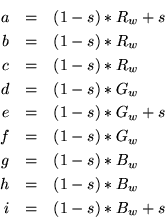



Next: 13.2.4.5 Hue Rotation
Up: 13.2.4 The Color Matrix
Previous: 13.2.4.3 Conversion to Luminance
Contents
The saturation of a color is the distance of that color from a
gray of equal intensity.[30] Haeberli has suggested
modifying saturation using the equation:
where:
with  ,
,  , and
, and  as described in the above section. Since
the saturation of a color is the difference between the color and a
gray value of equal intensity, it is comforting to note that setting
as described in the above section. Since
the saturation of a color is the difference between the color and a
gray value of equal intensity, it is comforting to note that setting
 to
to  gives the luminance equation. Setting
gives the luminance equation. Setting  to
to  leaves
the saturation unchanged; setting it to
leaves
the saturation unchanged; setting it to  takes the complement of
the colors [42].
takes the complement of
the colors [42].
2001-01-10
![\begin{displaymath}
\left[
\begin{array}{cccc}
R' \\
G' \\
B' \\
A
\end{array...
...\left[
\begin{array}{c}
R \\
G \\
B \\
A
\end{array}\right]
\end{displaymath}](img355.gif)
![\begin{displaymath}
\left[
\begin{array}{cccc}
R' \\
G' \\
B' \\
A
\end{array...
...\left[
\begin{array}{c}
R \\
G \\
B \\
A
\end{array}\right]
\end{displaymath}](img355.gif)
